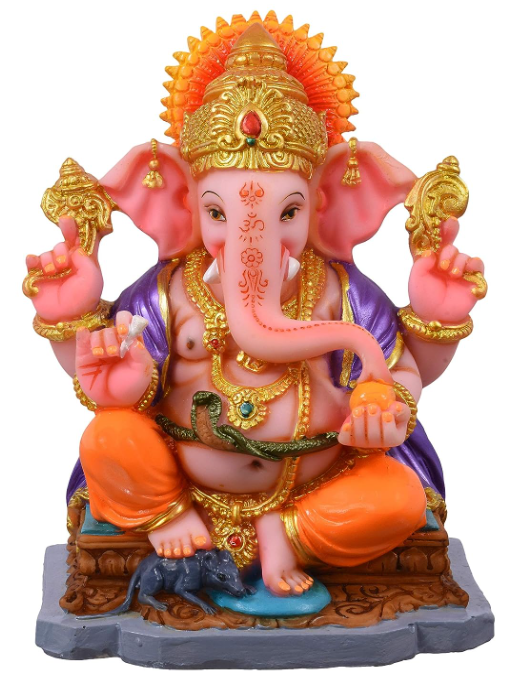Ganesh Chaturthi also known as Vinayak Chaturthi is a Hindu festival commemorating the birth of the Hindu god Ganesha. The festival is marked with the installation of Ganesha’s clay idols privately in homes and publicly on elaborate pandals. Observances include chanting of Vedic hymns and Hindu texts, such as prayers and vrata (fasting). Offerings and prasada from the daily prayers, that are distributed from the pandal to the community, include sweets such as modaka as it is believed to be a favorite of Ganesha. The festival ends on the tenth day after start, when the idol is carried in a public procession with music and group chanting, then immersed in a nearby body of water such as a river or sea, called visarjan. The visarjan ritual symbolizes the cycle of birth and death. It celebrates the reality of life that revolves around these two facts.Thereafter, the clay idol dissolves and Ganesha is believed to return to his celestial abode.
The festival celebrates Ganesha as the God of New Beginnings and the Remover of Obstacles as well as the god of wisdom and intelligence.

There are 3 popular stories about Ganesha:
1. The elephant head of Ganesha as narrated in Shiva Purana
The goddess Parvati had started preparing for a bath. As she did not want to be disturbed during her bath and since Nandi was not at Kailash to keep guard of the door, Parvati took the turmeric and sandalwood paste (for bathing) from her body and made a statue of a boy, breathing life into him. This boy was instructed by Parvati to guard the door and to not let anyone in until she had finished her bath.
After Shiva had come out of his meditation, he wished to meet Parvati, but found himself being halted by a strange boy. Shiva tried to reason with the boy, saying that he was Parvati’s husband, but the boy did not listen and was determined to keep Shiva at bay. The boy’s behaviour surprised Shiva. Sensing that this was no ordinary boy, the usually even tempered Shiva decided he would have to fight the boy and in his divine fury, severed the boy’s head with his trishula, killing him instantly.
When Parvati heard word of this, she was so enraged that she decided to destroy all of creation. At her call, several ferocious multi-armed forms, the yoginis, arose from her body and threatened annihilation. Brahma, being the creator, naturally had his concerns, and pleaded that she reconsider her drastic plan. She acquiesced with two conditions: one, that the boy be brought back to life, and two, that he be forever revered before all the other gods in prayer.
Shiva, having cooled down by this point, agreed to Parvati’s conditions. He sent his devotees out with orders to bring back the head of the first creature that lay with its head facing the north. They soon returned with the head of a strong and powerful elephant named Gajasura, which Brahma placed atop the boy’s body. Breathing new life into him, he was declared as the Gajanana and offered him the status of being the foremost among the gods in prayer, and the title of the leader of all the ganas (classes of beings), Ganapati.
2. The half-broken left tusk
It’s said that Ganesha wrote the Mahabharata, as it was recited to him by sage Veda Vyasa. This was done on the condition that Vyasa would not stop while reciting the epic and that Ganesha would not stop while writing, besides the condition that Ganesha would not merely write it, but also understand every verse of it. Popular legends say that it took both of them three years of continuous speaking and writing to complete the epic.
If you’ve ever noticed the idol of Lord Ganesha carefully, you’d have noticed the broken tusk. As legend goes, when Ganesha was writing the Mahabharata, the feather he was writing with broke. So, to stick to the condition of writing continuously, Ganesha broke his tusk and wrote with it.
There is yet another version of this half tusk story,
Some are also of the belief that Lord Parashurama cut off one of Ganesha’s tusks because he didn’t allow him to enter the Shiva abode and meet Lord Shiva, who was busy praying.
3. Mouse as his vehicle – Mushikavaahana
Now, there are two theories to this:
First, in ancient times, when agriculture was the primary mode of sustenance, rodents were one of the biggest obstacles to prosperity–as they are for farmers even today. Destroying crops, eating stored grains are all in a day’s work for a rodent. Lord Ganesha, in having a mouse/rat as his vehicle, is symbolically shown to have conquered this pest, thus staying true to his name and work as the destroyer of obstacles.
Second, Lord Ganesha was able to reach all the nooks and crannies of the world–and do his duty as the destroyer of obstacles–because his vehicle was a mouse–because mice/rats can slither through tiny holes and narrow pathways.
So these are the popular stories behind Ganesh Chathurthi festival. Happy Festival to you.
